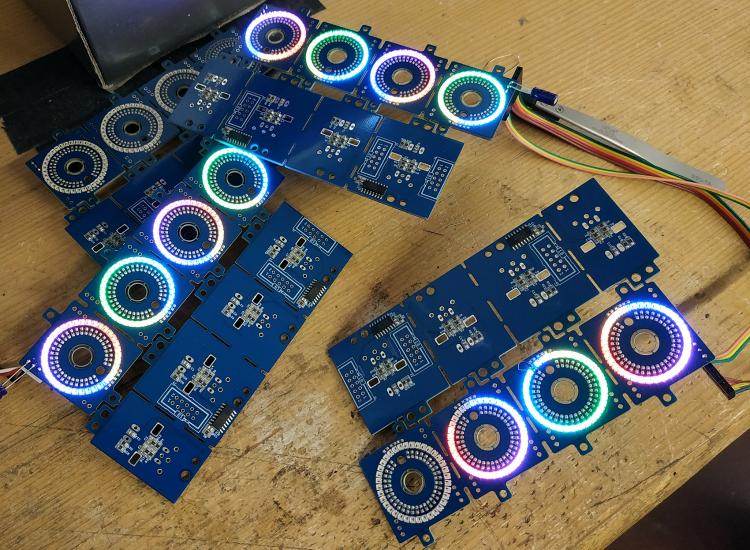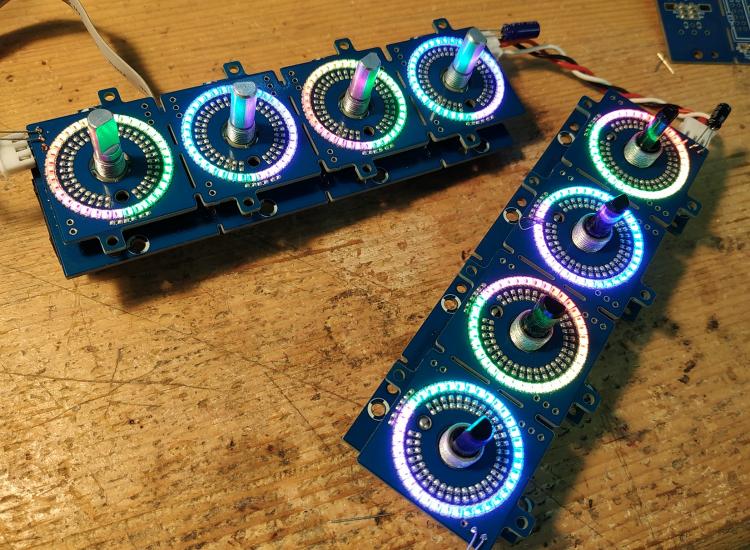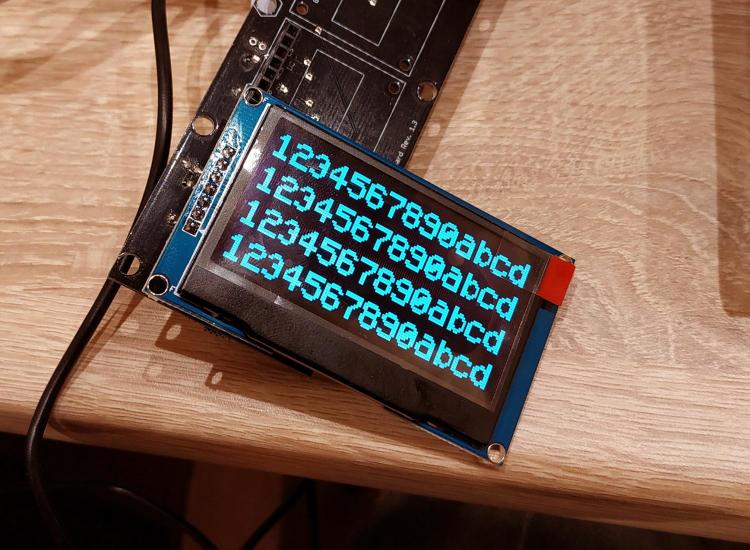
FantomXR
Members-
Posts
1,035 -
Joined
-
Last visited
-
Days Won
22
Content Type
Profiles
Forums
Blogs
Gallery
Everything posted by FantomXR
-
Thank you very much! I'll give it a try.
-
I did some tests with this. I connected a DIO-Board to my keyboard and the DIO-board to the core with jumper wire => no HCT541. I powered the DIO with 3V3 from the DISCO-Board. The result: It's running fine. No issues. I checked the clock with my oscilloscope. It looks very clean. Also no issues here. So, I think I'll leave away the HCT541 for my applications and run everything from 3V3. //edit: I've connected an encoder to the DIO-board. Works also fine.
-
Dear TK, I undo all changes and added the lines as you suggested. Unfortunately I can not get it working. I edited the ainser.h like this: s32 AINSER_Init(u32 mode) { MIOS32_BOARD_J10_PinInit(0, MIOS32_BOARD_PIN_MODE_OUTPUT_PP); s32 status = 0; int module, pin; // currently only mode 0 supported if( mode != 0 ) return -1; // unsupported mode #if AINSER_SPI_OUTPUTS_OD // pins in open drain mode (to pull-up the outputs to 5V) status |= MIOS32_SPI_IO_Init(AINSER_SPI, MIOS32_SPI_PIN_DRIVER_STRONG_OD); #else // pins in push-poll mode (3.3V output voltage) status |= MIOS32_SPI_IO_Init(AINSER_SPI, MIOS32_SPI_PIN_DRIVER_STRONG); #endif // SPI Port will be initialized in AINSER_Update() num_used_modules = AINSER_NUM_MODULES; #if AINSER_NUM_MODULES > 8 # error "If more than 8 AINSER_NUM_MODULES should be supported, the ainser_enable_mask variable type has to be changed from u8 to u16 (up to 16) or u32 (up to 32)" #endif #if AINSER_NUM_MODULES > 8 # error "If more than 8 AINSER_NUM_MODULES should be supported, the ainser_muxed_mask variable type has to be changed from u8 to u16 (up to 16) or u32 (up to 32)" #endif for(module=0; module<AINSER_NUM_MODULES; ++module) { num_used_pins[module] = AINSER_NUM_PINS; // ensure that CS is deactivated AINSER_SetCs(module, 1); AINSER_EnabledSet(module, 1); AINSER_MuxedSet(module, 1); AINSER_NumPinsSet(module, AINSER_NUM_PINS); AINSER_DeadbandSet(module, MIOS32_AIN_DEADBAND); // clear all values for(pin=0; pin<AINSER_NUM_PINS; ++pin) { ain_pin_values[module][pin] = 0; } previous_ain_pin_value = 0; } return status; } [] static s32 AINSER_SetCs(u8 module, u8 value) { switch( module ) { case 0: return MIOS32_SPI_RC_PinSet(AINSER_SPI, AINSER_SPI_RC_PIN_MODULE1, value); // spi, rc_pin, pin_value case 1: return MIOS32_SPI_RC_PinSet(AINSER_SPI, AINSER_SPI_RC_PIN_MODULE2, value); // spi, rc_pin, pin_value case 2: return MIOS32_BOARD_J10_PinSet(0, value); #if AINSER_NUM_MODULES > 3 # error "CS Line for more than 2 modules not prepared yet - please enhance here!" #endif } But when I now connect the Chipselect to PE8, which is D0 on J10A, nothing happens. Any idea? Thanks, Chris
-
Thanks for chiming in! Is it really so easy? :-) Thanks! I'll try it!!
-
what would your perfect control surface look like and do?
FantomXR replied to madbutnotmad's topic in MIDIbox NG
I've made it already :-) 9x Encoders + 1 Potentiometer for master-volume 9x OLEDs 9x Faders 3x9 Button-rows 9x RGBLED-bars next to the faders 9x RGBLED underneath each encoder I don't need anything more! -
Of course there are tons of other ICs, that are very usable but are not supported by MIDIbox though a dedicated driver is needed. I thought that the STP may can be used with very little changes in the firmware but giving a great benefit. TLC5958 is a complete other story I think.
-
Isn't it 5-90mA per channel?
-
This seems to be a good hint! Thanks! Maybe @TK. could guide us in the right direction! :-)
-
No but I followed up the logic in the code above: // Which RC pin of the SPI port should be used for the first module // allowed values: 0 or 1 for SPI0 (J16:RC1, J16:RC2), 0 for SPI1 (J8/9:RC), 0 or 1 for SPI2 (J19:RC1, J19:RC2) #ifndef AINSER_SPI_RC_PIN_MODULE1 #define AINSER_SPI_RC_PIN_MODULE1 0 #endif // Which RC pin of the SPI port should be used for the second module // allowed values: 0 or 1 for SPI0 (J16:RC1, J16:RC2), 0 for SPI1 (J8/9:RC), 0 or 1 for SPI2 (J19:RC1, J19:RC2) #ifndef AINSER_SPI_RC_PIN_MODULE2 #define AINSER_SPI_RC_PIN_MODULE2 1 #endif // Which RC pin of the SPI port should be used for the third module // allowed values: 0 or 1 for SPI0 (J16:RC1, J16:RC2), 0 for SPI1 (J8/9:RC), 0 or 1 for SPI2 (J19:RC1, J19:RC2) #ifndef AINSER_SPI_RC_PIN_MODULE3 #define AINSER_SPI_RC_PIN_MODULE3 2 Not in ainser.h, but in the mio32_config.h with: // enable three AINSER modules #define AINSER_NUM_MODULES 3 Sure! I did this: static s32 AINSER_SetCs(u8 module, u8 value) { switch( module ) { case 0: return MIOS32_SPI_RC_PinSet(AINSER_SPI, AINSER_SPI_RC_PIN_MODULE1, value); // spi, rc_pin, pin_value case 1: return MIOS32_SPI_RC_PinSet(AINSER_SPI, AINSER_SPI_RC_PIN_MODULE2, value); // spi, rc_pin, pin_value case 2: return MIOS32_SPI_RC_PinSet(AINSER_SPI, AINSER_SPI_RC_PIN_MODULE3, value); // spi, rc_pin, pin_value #if AINSER_NUM_MODULES > 3 # error "CS Line for more than 2 modules not prepared yet - please enhance here!" #endif }
-
Hey people, a friend of mine just told me about the STP16CPC. It looks great. It can be accessed via SPI, it has 16 outputs and a current-setting. So if one would like to build LED-Rings this looks like a great solution with very less parts-count. You wouldn't need any current-limiting resistors in front of the LEDs and only one IC to drive 16 LEDs. So, does anyone used this IC before and does it work in a classic DIO-chain without changes on the code? I took a look into the datasheet but I'm not sure. The STP has a LE-input which the HC595 doesn't have. But it might work if one connect the chipselect (RC) which is normally connected to RCLK on the HC595 to the LE of the STP. Thanks, Chris
-
Hi Zam! Thanks for your reply. I've tried that without success. Yes. I prefer having more traces (=not muxed) instead of having less traces and more parts (=muxed). I want to get rid of HC595 and 4051. In my application I need about 20 analog inputs. So, unfortunately 16ch. are not enough. I thought that too. But I comment out those lines. Also I did a double check I took these lines from mios32_spi.h: #define MIOS32_SPI2_RCLK1_PORT GPIOA // RC1 #define MIOS32_SPI2_RCLK1_PIN GPIO_Pin_15 #define MIOS32_SPI2_RCLK1_AF { GPIO_PinAFConfig(GPIOA, GPIO_PinSource15, GPIO_AF_SPI3); } // only relevant for slave mode #define MIOS32_SPI2_RCLK2_PORT GPIOB // RC2 #define MIOS32_SPI2_RCLK2_PIN GPIO_Pin_8 #define MIOS32_SPI2_RCLK2_AF { } #define MIOS32_SPI2_RCLK3_PORT GPIOC // RC3 #define MIOS32_SPI2_RCLK3_PIN GPIO_Pin_1 #define MIOS32_SPI2_RCLK3_AF { } and changed the pin for RC1 to PC1 like this: #define MIOS32_SPI2_RCLK1_PORT GPIOC // RC1 #define MIOS32_SPI2_RCLK1_PIN GPIO_Pin_1 #define MIOS32_SPI2_RCLK1_AF { GPIO_PinAFConfig(GPIOC, GPIO_PinSource1, GPIO_AF_SPI3); } // only relevant for slave mode #define MIOS32_SPI2_RCLK2_PORT GPIOB // RC2 #define MIOS32_SPI2_RCLK2_PIN GPIO_Pin_8 #define MIOS32_SPI2_RCLK2_AF { } #define MIOS32_SPI2_RCLK3_PORT GPIOC // RC3 #define MIOS32_SPI2_RCLK3_PIN GPIO_Pin_1 #define MIOS32_SPI2_RCLK3_AF { } And this is working great (of course with cs=0 in the NGC-file). So I don't think that PC1 is somehow "blocked" for this application. It can't be to hard to add more CS. I think I just overlook something...
-
Hey people, I'd like to add one or two chip-selects for the AINSER8. I've already made a few changes to the firmware but it's not working yet. Under modules I've edited the ainser.c: { switch( module ) { case 0: return MIOS32_SPI_RC_PinSet(AINSER_SPI, AINSER_SPI_RC_PIN_MODULE1, value); // spi, rc_pin, pin_value case 1: return MIOS32_SPI_RC_PinSet(AINSER_SPI, AINSER_SPI_RC_PIN_MODULE2, value); // spi, rc_pin, pin_value case 2: return MIOS32_SPI_RC_PinSet(AINSER_SPI, AINSER_SPI_RC_PIN_MODULE3, value); // spi, rc_pin, pin_value #if AINSER_NUM_MODULES > 3 # error "CS Line for more than 2 modules not prepared yet - please enhance here!" #endif } and ainser.h: // Which RC pin of the SPI port should be used for the third module // allowed values: 0 or 1 for SPI0 (J16:RC1, J16:RC2), 0 for SPI1 (J8/9:RC), 0 or 1 for SPI2 (J19:RC1, J19:RC2) #ifndef AINSER_SPI_RC_PIN_MODULE3 #define AINSER_SPI_RC_PIN_MODULE3 2 #endif and mios32_spi,h #define MIOS32_SPI2_RCLK1_PORT GPIOA // RC1 #define MIOS32_SPI2_RCLK1_PIN GPIO_Pin_15 #define MIOS32_SPI2_RCLK1_AF { GPIO_PinAFConfig(GPIOA, GPIO_PinSource15, GPIO_AF_SPI3); } // only relevant for slave mode #define MIOS32_SPI2_RCLK2_PORT GPIOB // RC2 #define MIOS32_SPI2_RCLK2_PIN GPIO_Pin_8 #define MIOS32_SPI2_RCLK2_AF { } #define MIOS32_SPI2_RCLK3_PORT GPIOC // RC3 #define MIOS32_SPI2_RCLK3_PIN GPIO_Pin_1 #define MIOS32_SPI2_RCLK3_AF { } #else MIOS32_SPI2_RCLK1_AF; MIOS32_SPI2_RCLK2_AF; MIOS32_SPI2_RCLK3_AF; MIOS32_SPI2_SCLK_AF; MIOS32_SPI2_MISO_AF; MIOS32_SPI2_MOSI_AF; if( slave ) { // SCLK and DOUT are inputs assigned to alternate functions GPIO_InitStructure.GPIO_Mode = GPIO_Mode_AF; GPIO_InitStructure.GPIO_Pin = MIOS32_SPI2_SCLK_PIN; GPIO_Init(MIOS32_SPI2_SCLK_PORT, &GPIO_InitStructure); GPIO_InitStructure.GPIO_Pin = MIOS32_SPI2_MOSI_PIN; GPIO_Init(MIOS32_SPI2_MOSI_PORT, &GPIO_InitStructure); // RCLK (resp. CS) are configured as inputs as well GPIO_InitStructure.GPIO_Mode = GPIO_Mode_AF; GPIO_InitStructure.GPIO_Pin = MIOS32_SPI2_RCLK1_PIN; GPIO_Init(MIOS32_SPI2_RCLK1_PORT, &GPIO_InitStructure); GPIO_InitStructure.GPIO_Pin = MIOS32_SPI2_RCLK2_PIN; GPIO_Init(MIOS32_SPI2_RCLK2_PORT, &GPIO_InitStructure); GPIO_InitStructure.GPIO_Pin = MIOS32_SPI2_RCLK3_PIN; GPIO_Init(MIOS32_SPI2_RCLK3_PORT, &GPIO_InitStructure); // DOUT is output assigned to alternate function GPIO_InitStructure.GPIO_Mode = GPIO_Mode_AF; GPIO_InitStructure.GPIO_Pin = MIOS32_SPI2_MISO_PIN; GPIO_Init(MIOS32_SPI2_MISO_PORT, &GPIO_InitStructure); } else { // SCLK and DIN are inputs GPIO_InitStructure.GPIO_Mode = GPIO_Mode_AF; GPIO_InitStructure.GPIO_Pin = MIOS32_SPI2_SCLK_PIN; GPIO_Init(MIOS32_SPI2_SCLK_PORT, &GPIO_InitStructure); GPIO_InitStructure.GPIO_Pin = MIOS32_SPI2_MOSI_PIN; GPIO_Init(MIOS32_SPI2_MOSI_PORT, &GPIO_InitStructure); // RCLK (resp. CS) are configured as inputs as well GPIO_InitStructure.GPIO_Mode = GPIO_Mode_OUT; GPIO_InitStructure.GPIO_Pin = MIOS32_SPI2_RCLK1_PIN; GPIO_Init(MIOS32_SPI2_RCLK1_PORT, &GPIO_InitStructure); GPIO_InitStructure.GPIO_Pin = MIOS32_SPI2_RCLK2_PIN; GPIO_Init(MIOS32_SPI2_RCLK2_PORT, &GPIO_InitStructure); GPIO_InitStructure.GPIO_Pin = MIOS32_SPI2_RCLK3_PIN; GPIO_Init(MIOS32_SPI2_RCLK3_PORT, &GPIO_InitStructure); // DIN is input with pull-up GPIO_InitStructure.GPIO_Mode = GPIO_Mode_AF; GPIO_InitStructure.GPIO_PuPd = GPIO_PuPd_UP; GPIO_InitStructure.GPIO_Pin = MIOS32_SPI2_MISO_PIN; GPIO_Init(MIOS32_SPI2_MISO_PORT, &GPIO_InitStructure); } #else switch( rc_pin ) { case 0: MIOS32_SYS_STM_PINSET(MIOS32_SPI2_RCLK1_PORT, MIOS32_SPI2_RCLK1_PIN, pin_value); break; case 1: MIOS32_SYS_STM_PINSET(MIOS32_SPI2_RCLK2_PORT, MIOS32_SPI2_RCLK2_PIN, pin_value); break; case 2: MIOS32_SYS_STM_PINSET(MIOS32_SPI2_RCLK3_PORT, MIOS32_SPI2_RCLK3_PIN, pin_value); break; default: return -4; // unsupported RC pin } break; #endif In the NGC I have: AINSER n=1 enabled=1 cs=2 num_pins=1 and nothing happens. Which part do I overlook for adding a CS? Thanks! Chris
-
The plan is not to use encoders. I'd like to use sin/con potentiometers, which will be connected to a MSP430 uC (which converts these signals to encoder-typical signals). So the whole circuit needs only 3V3. I'd like to avoid routing two supply rails on my PCB.
-
Yes. But I could use LV165 or not? That could be supplied with 3V3.
-
I have another question regarding the ICs. For what reason do we use the HCT541? It does level-shifting and buffering. So if we want to drive only small distances, this might be obsolete? And if we take HCT595 and HCT165 the level of the signals the STM outputs should fit or not?
-
You can chain them via midi I/O easily. If you want to connect multiple midiboxes via USB you would need to define different USB descriptions in the firmware which means you need to be able to compile firmwares by yourself.
-
LRE 4x1 breakable RGB LED-Ring/Rotary-Encoder PCB bulk order
FantomXR replied to weasel's topic in Bulk Orders
If I understood him correctly he wants to avoid the Arduino solution. It will make things a lot more complicated. But an Arduino can drive tons of LEDs without problems. That's why he uses it. Let's see what he says :-) -
LRE 4x1 breakable RGB LED-Ring/Rotary-Encoder PCB bulk order
FantomXR replied to weasel's topic in Bulk Orders
That sounds great! And... are you willing to do so? :-D Awesome work @Antichambre. Looks fabulous. Could you tell us where you have the translucent PMMA from? I buy my materials at TroTec. They have also awesome stuff! -
LRE 4x1 breakable RGB LED-Ring/Rotary-Encoder PCB bulk order
FantomXR replied to weasel's topic in Bulk Orders
Thanks for your explanation, pictures and videos. Well, as I told you in an email already you really should think about, going down with the LED-count while keeping the diameter as is now. This will give you some space between the LEDs and it should be very easy creating a mask for it so you don't have any crossbleeding ;-) -
I don't want them to be detented.
-
Hey people, I'm looking for encoders. The pinout doesn't matter as well as the gird. The only thing that is important is, that they have a great feel. All encoders I've tested (PEC11, PEC12, PEC16, EC12, EC16) are too "light" so to say. There is no resistance when turning the knob. I need encoders that need more torque to get turned. Any ideas where I can find those? Best, Chris
-
LRE 4x1 breakable RGB LED-Ring/Rotary-Encoder PCB bulk order
FantomXR replied to weasel's topic in Bulk Orders
Looks great! :-) -
LRE 4x1 breakable RGB LED-Ring/Rotary-Encoder PCB bulk order
FantomXR replied to weasel's topic in Bulk Orders
Hey people, thanks to @TK.! It's working great. Anyway I had still some flickering on the LEDs. As I stated above I left away the caps ... and this was the reason. I know have added a 10uF on the input and on the output-connector of the LED-rings and the flickering is completely eliminated! Great!! So, one core can handle a total of 10 LED (10*36=360) rings.... -
LRE 4x1 breakable RGB LED-Ring/Rotary-Encoder PCB bulk order
FantomXR replied to weasel's topic in Bulk Orders
Hey Thorsten, Great! I'll test it tomorrow with the rings. So, what do you think is the limit regarding led-count? Thank you very much! Chris -




